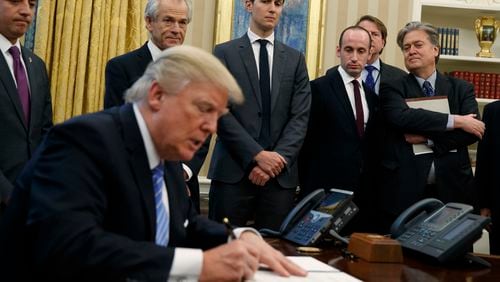Donald Trump signed a notice Monday starting the United States' withdrawal from the proposed Trans-Pacific Partnership trade deal.
The trade deal, signed by 12 countries last February, must be ratified by all 12 members to go into effect. It aims to slash tariffs and boost trade among Pacific Rim nation members.
Here’s a quick look at the TPP.
What is it?
Twelve member countries -- the U.S., Japan, Malaysia, Vietnam, Singapore, Brunei, Australia, New Zealand, Canada, Mexico, Chile and Peru -- formed a pact that would foster trade among the countries. The partnership covers 40 percent of the world’s economy and would, according to proponents, grow jobs and slash tariffs, which are taxes on imported items.
China is not included in the partnership.
Opponents say they can’t tell what TPP would do since not all details of the deal have been released. Another complaint is that the agreement was designed to eventually create a new single market -- something like the European Union.
Does the partnership include all goods traded between the countries?
Not all, but most goods traded between the members are included in the deal. Tariffs on some goods would not be removed, and some tariffs would take longer than others to be removed. For example, tariffs on U.S. manufactured goods and almost all U.S. farm products would be lifted almost immediately. There are some 18,000 taxes the member countries put on American-made products imported into those countries.
What do proponents of TPP like about it?
One thing they like about the deal would be the expectation that China’s neighbors would come to appreciate being a trading partner with the United States and having access to goods and services provided by American workers. In turn, they would turn away from trading with China.
Supporters also say TPP would offer greater access to more and different goods and services.
What about those opposed to the deal?
Those against TPP mainly cite job losses as their major concern. If trade is freer and companies are allowed to move factories to other member nations, U.S. jobs could be lost, they say.
Another criticism is that the negotiations took place in secret and no one knows what is in the agreement. Those negotiating say nothing was said publicly earlier in the process because the deal had not been made.
What happens next?
The United States signed the deal at the end of 2015. However, the deal has not been ratified -- something that requires congressional action.
Trump said during the campaign that on day one he would issue a notification of intent to withdraw from TPP, and that is what he did Monday.
So what happens going forward? What, if anything, would take its place?
"Instead we will negotiate fair, bilateral trade deals that bring jobs and industry back onto American shores,” Trump said in November.






